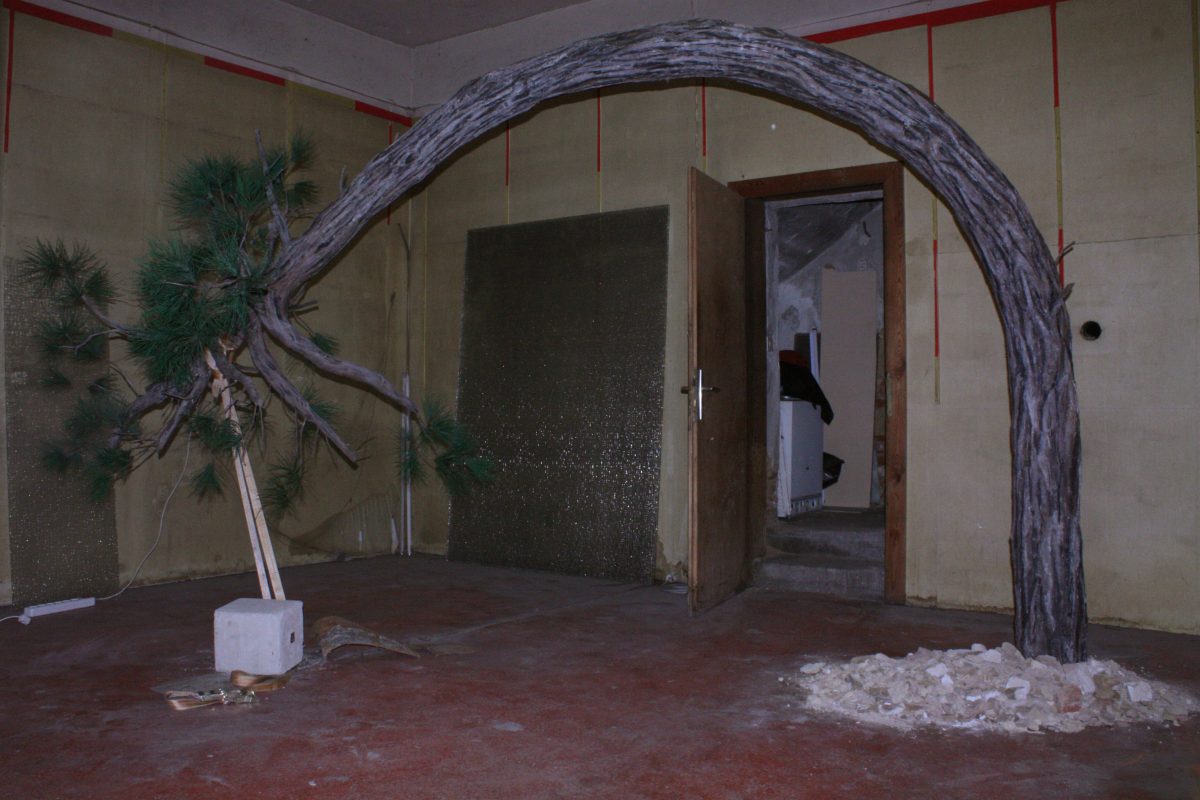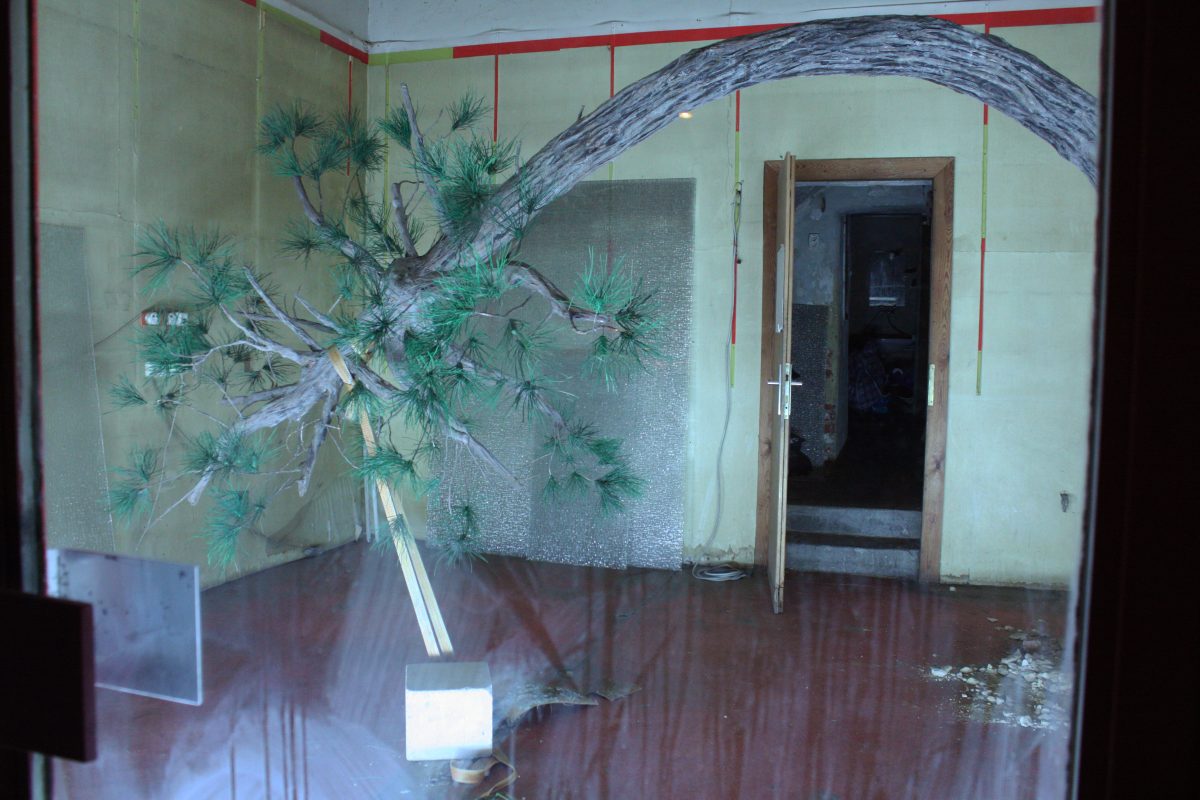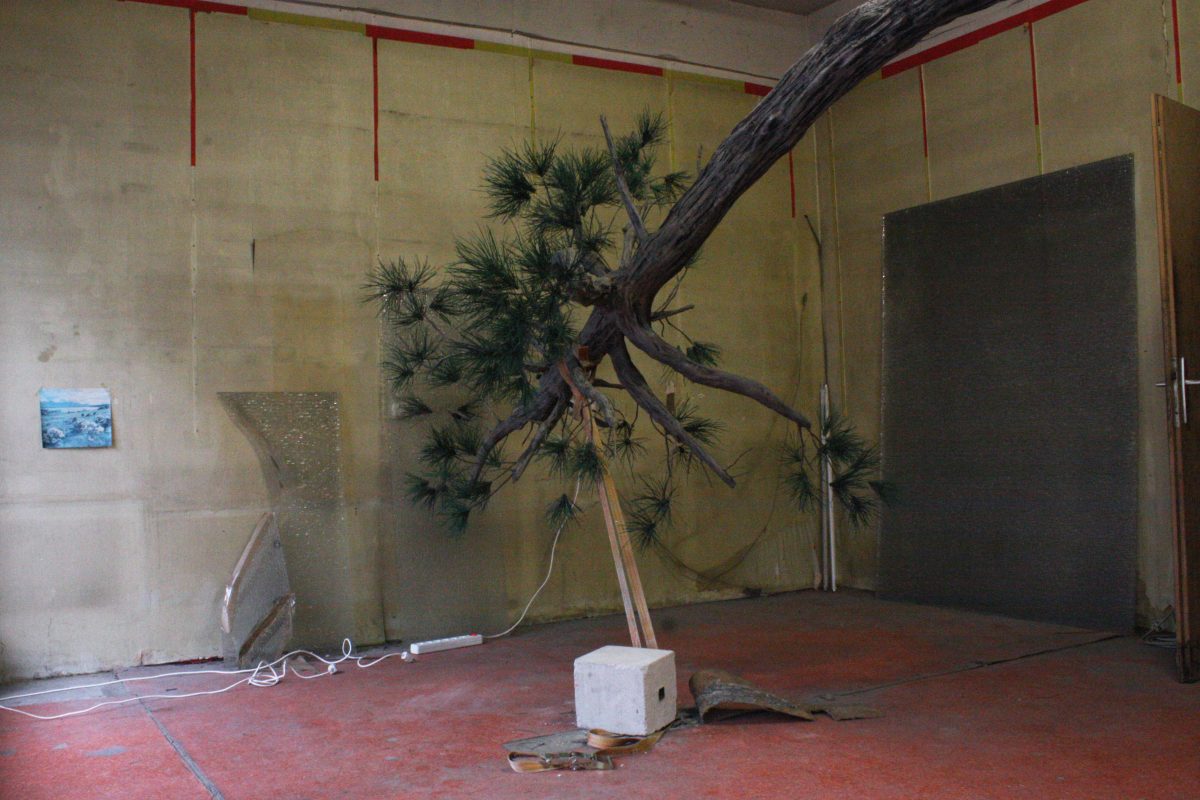(The installation can be seen 23. to 26. June 2020 (24/7) at Äußere Mariahilfer Straße 171, 1150 Vienna. I will be there every day between 5 and 7 pm.)
The installation based on Euripides Bakchen circles the relationship of a post-modern, eurocentric image of man as opposed to nature, which are made visible through the worldly ruler Pentheus and the god Dionysus in the piece. The installation connects a 2462 year old text to contemporary society. It identifies Dionysus as everything which lives and is nature, and Penteus as definition of humanity, which exploits nature’s resources for the european man and subjects it to his plans and understanding. Even though Pentheus and Dionysus may seem to be antagonists at first, when read closely they are intertwined, entangled. Pentheus can not be thought without Dionysus, as nature is not a mere resource but the very basis of life itself. I would like to invite you to have a look at a shop window. The shop was abandoned, I do not know why. I do know what they used to sell. Knitwear and electronics. The shop stopped fulfilling its purpose, nothing is being sold here (or maybe there is?). The space contains the context of the ruin of consumerism. So if you stand in front of the window. you look into the shop from the outside. In the shop there is a pine. Even though I put it there, it would be good if we could agree that the pine is just what it is, it may have grown there. But if you refuse that’s fine too. The pine is bent in tension and towed to the ground with webbing. Which potentials are within this picture? In which direction can the pine’s tension erupt? Will it break the ceiling or will it break the trunk? The installation proposes a way of reading “Bakchen”, which implies that global warming is truly happening and capitalist productions are it’s cause. It is supposed to expose the european, post-enlightened understanding of the relationship between humans and nature, and in the following question the communicatory and translatory aspects of visualising content in space. Is there a subversive moment, one that manages to cross the border of reproductive relationships? Is the pine a passive object in space, or does it become a global agent? And another question arises: how passive/active is looking through a shop window really?
____________________________________________________________
(Zu sehen: 23.-26. Juni 2020 (0-24 Uhr) in der Äußeren Mariahilferstr. 171, 1150 Wien. Ich werde jeden Tag von 17-19Uhr da sein.)
Die Rauminstallation zu Euripides’ Bakchen beschäftigt sich mit dem Verhältnis eines post-modernen, eurozentristischen, Menschenbild und Natur, welches im Stück aus der Beziehung eines weltlichen Herrschers mit dem Gott Dionysos sichtbar wird. Die Installation versucht einen heutigen Bezug zu einem 2462 Jahre alten Text herzustellen, identifiziert Dionysos mit allem was in der Lebendigkeit der Natur enthalten ist und Pentheus mit einem Menschheitsbegriff, der Natur als Resource für die Unternehmungen des europäischen Mannes sieht, und der sich selbst als Herrscher über die Natur begreift und diese seinem Vorhaben und Verständnis unterwirft. Auch wenn sie auf den ersten Blick wie Antagonisten wirken, sind sie bei näherer Betrachtung miteinander verbunden oder gar verknotet. Denn Dionysos ist in Pentheus enthalten und nicht von ihm zu trennen, denn Natur ist nicht Resource sondern überhaupt erst Grundlage von menschlicher Existenz. Ich lade Sie ein einen Blick zu werfen, in ein Schaufenster von einem Ladenlokal. Es wurde verlassen, warum weiß ich nicht. Ich weiß aber, dass hier mal was verkauft wurde. Unter anderem Strickwaren und Elektroartikel. Seinen Zweck erfüllt das Ladenlokal jetzt jedenfalls nicht mehr, hier werden keine Waren mehr veräußert (oder vielleicht doch?). Jedenfalls ist dieser Kontext, den der gefundene Ort aufmacht, als eine Ruine des Verkaufs, enthalten. Wenn Sie also vor dem Schaufenster stehen, sehen sie von außen in das Ladenlokal hinein. Dort steht dann eine Kiefer. Die habe ich zwar dahin gestellt, aber es wäre gut wenn wir uns darauf einigen könnten, sie einfach als eine Kiefer zu verstehen, die dort vielleicht sogar gewachsen ist, aber wenn Sie das gar nicht wollen, ist das auch in Ordnung. Diese Kiefer ist unter Spannung gebogen und durch ein Gurtband und andere Befestigungen am Boden in Form gehalten. Welche Potentiale sind in diesem Bild enthalten? In welche Richtung kann sich die Spannung des Baums entladen? Wird die Decke des Ladens durchbrochen oder bricht eher der Stamm? Die Arbeit macht einen Vorschlag für eine Lesart der Bakchen, die im Kopf behält, dass der Klimawandel wirklich passiert und, dass die kapitalistische Produktionsweise seine Ursache ist. Es soll darum gehen, die europäische, post-aufklärerische Selbstverständlichkeit der Mensch—Natur Beziehung zu auszustellen und darüber hinaus auch das Kommunizierende, Übersetzende von einem Inhalt in eine räumliche Situation zu befragen. Gibt es einen subversives Moment, also eines, das es schafft über die Grenze der Reproduktion von Verhältnissen hinauszugelangen? Ist die Kiefer im Ladenlokal passives Objekt oder Akteurin in der Welt? Und gleichzeitig ergibt sich die Frage: wie passiv/aktiv ist Schauen durch ein Schaufenster denn eigentlich?





